Tsoureki is the traditional Greek Easter bread made on Holy Thursday leading to Orthodox Easter. My tsoureki recipe includes complete step by step instructions to help you make the best Greek Easter bread!

CONTENTS
What is tsoureki?
- Tsoureki is a sweet bread prepared during Orthodox Easter activities and enjoyed on Easter Sunday after 40 days of Lent. It's very similar to challah or brioche; however, it has a distinct taste and aroma of mahlepi or mahleb (ground cherry seeds) and mastiha or mastic (pine resin natural gum from the island of Chios). Don't be scared by these ingredients - as they are available in most specialist ethnic shops or online.
- You can buy tsoureki all year round in Greece, and they come in a variety of toppings and flavours. The chocolate-dipped one is quite popular in Thessaloniki.
- The Easter variety often has dyed red eggs in the centre - a Greek Orthodox Easter tradition that symbolises the blood of Christ.
Why I love this recipe
- It's traditional - The week leading up to Easter Sunday is termed "Holy Week", with church services every night. It's a busy week, with lots of food preparation. Households are busy making and prepping koulourakia (Greek Easter Cookies), kourabiedes (Greek Easter Cookies) and Greek Easter eggs.
- If stored properly, it keeps well for several days, never losing its distinct taste. It freezes well too.
- It's versatile - While I enjoy dipping my tsoureki in coffee for breakfast, I also love making French toast with it too! Trust me on this - tsoureki French toast is a thing! I've also used it as a bread and butter pudding base with excellent results. If you like to dabble with baking, try my pumpkin and cardamom tsoureki - very modern and very different!
What goes into this recipe
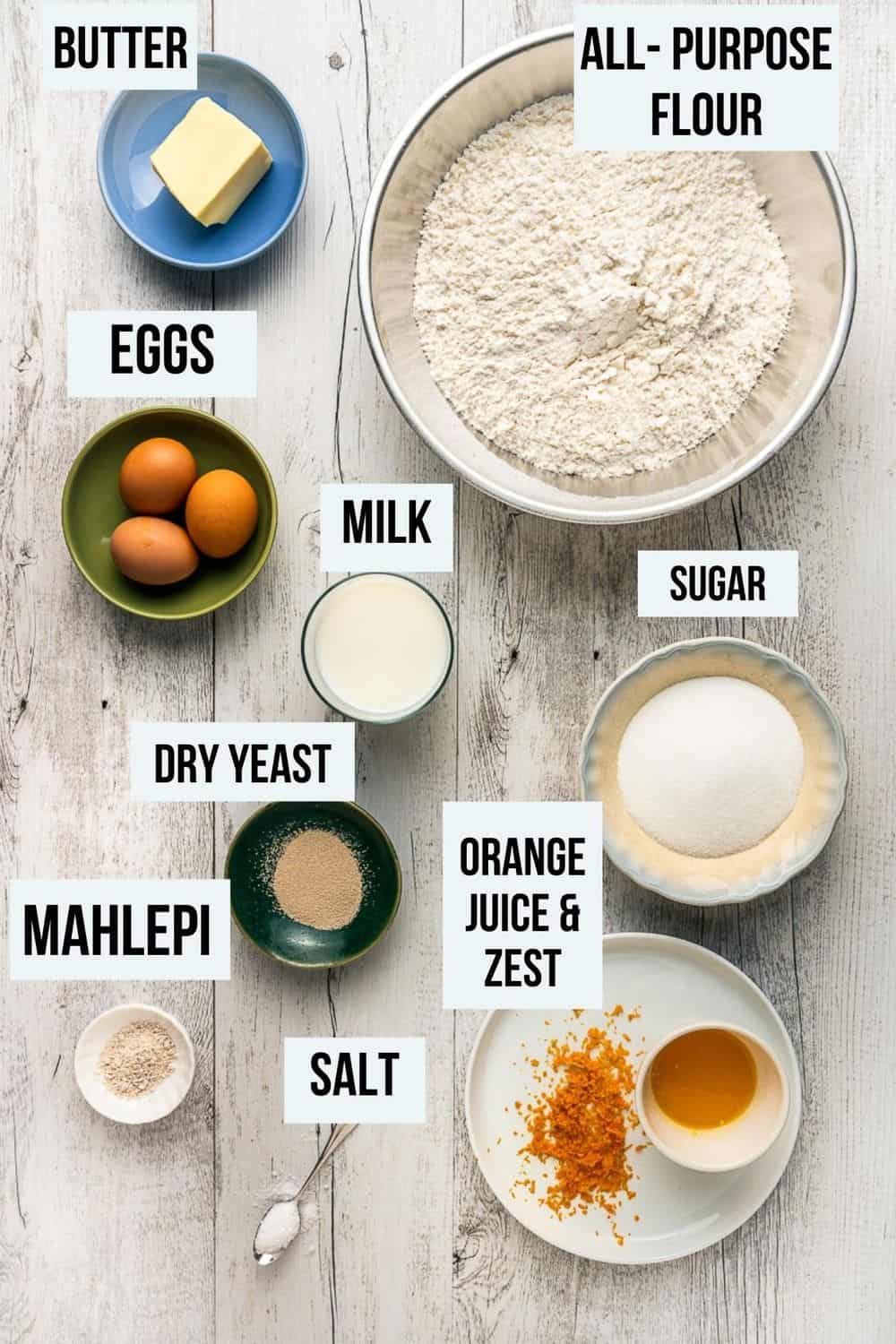
- Milk - use full-fat if possible.
- Butter - unsalted and room temperature.
- All-purpose flour - you can sub with a stronger bread flour. Do not use whole wheat flour.
- Salt - a little goes a long way in helping the dough.
- Orange juice and orange zest - the orange flavour is distinct, so don't skimp on this. I don't recommend substituting with any other citrus fruits.
- Dry Yeast - This will help our Greek Easter bread rise. You can sub with instant yeast - omit the first part where you allow the yeast to "bloom".
- Eggs - my eggs weighed 6o grams and are at room temperature.
- Mahlepi - this is also known as mahleb. It's a specialty ingredient that gives the tsoureki its unique flavour. The smell is distinct (not unpleasant at all) and is often associated with this famous Greek Easter bread.
- Mastic - a small amount is added. Leave it out if you can't source it.
For the egg wash:
- One egg yolk
- a splash of milk
Top with flaked or slivered almonds or sesame seeds (not pictured).
⭐️ Related: See my Greek bread recipe - easy and traditional!
How to make this recipe
Making tsoureki might seem daunting and laborious, but I've broken down the process to make a little easier for you.
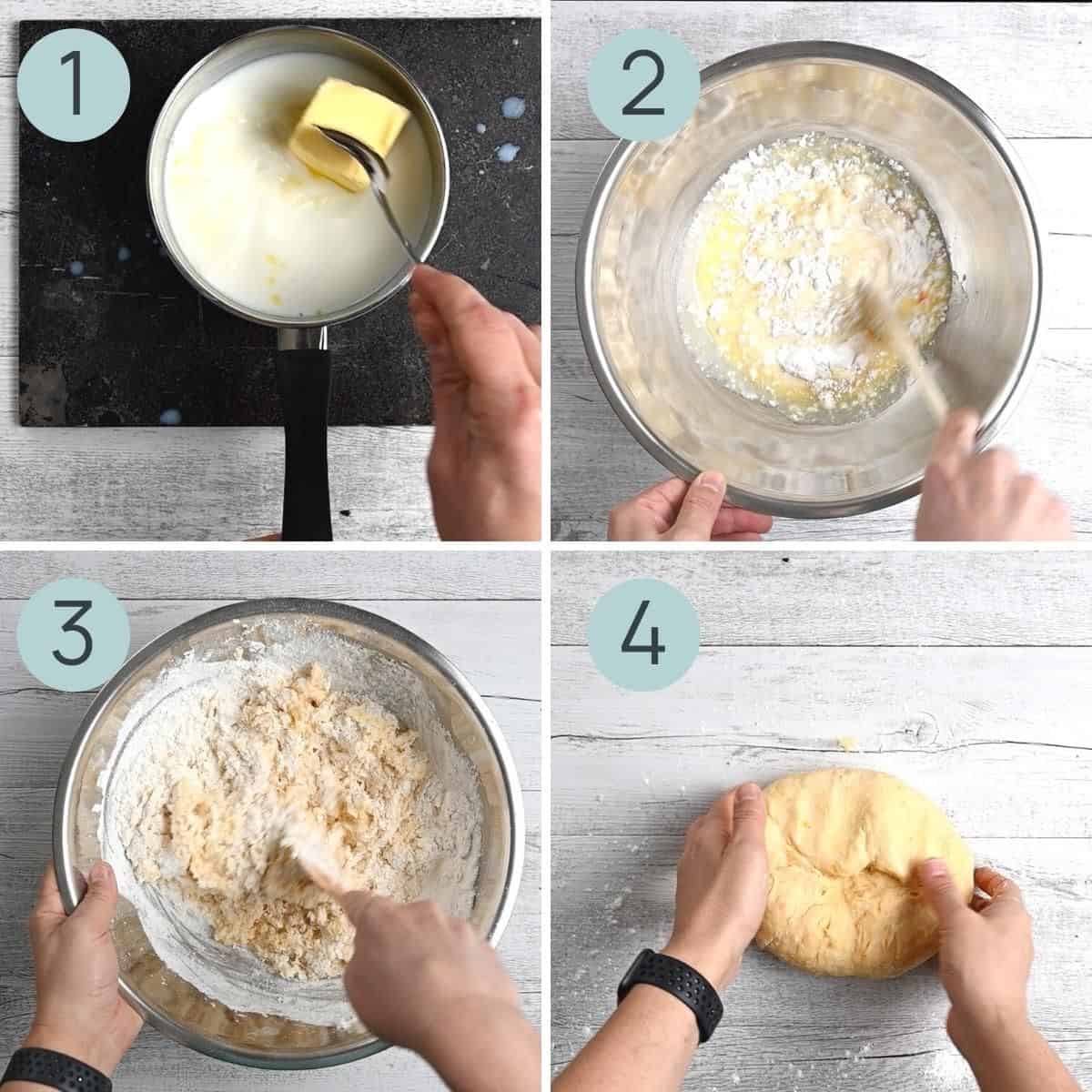
- Step 1: Warm the milk in a saucepan over low heat. Add the butter stirring it into the milk so it melts. Allow to cool.
- Step 2: In a large bowl, place 100 grams of the flour with the yeast, salt, orange zest and one teaspoon of the sugar. Pour in the cooled milk/butter mixture and beat with a wooden spoon until you have a mix that resembles a thick batter. Cover with saran (plastic) wrap and a towel and leave it to rest for about half an hour.
- Step 3: Your mixture should be bubbling and doubled in size when you return. Add the remaining flour, sugar, orange juice, mahlepi and eggs. Mix until a soft dough forms. (If you find it's sticky, add more flour. But be careful not to add too much. We're after an elastic, silky dough).
- Step 4: Knead for 10 minutes. Alternatively, you can follow these instructions using a stand mixer.
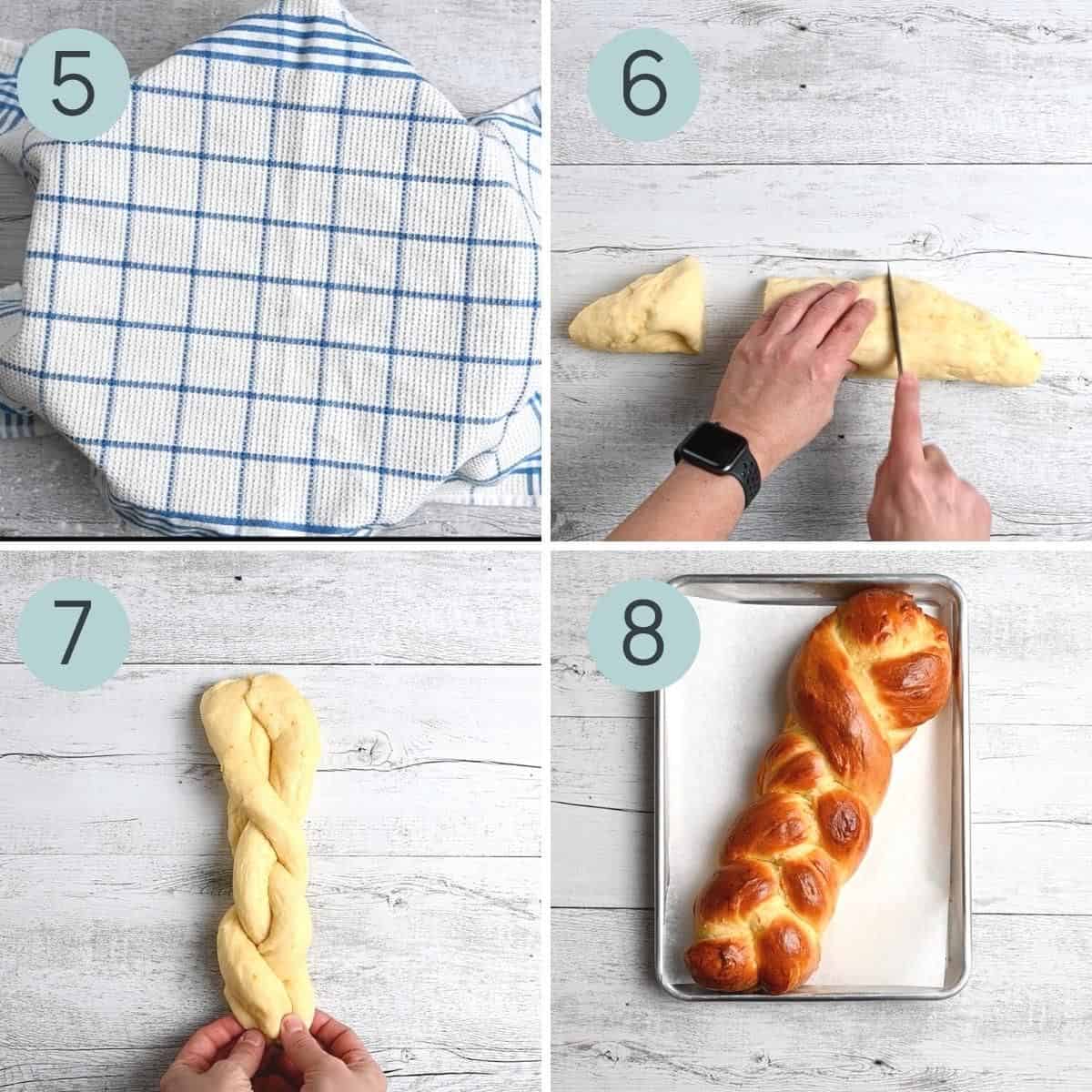
- Step 5: Once kneaded, place in an oiled bowl and lightly oil the top of the dough. Cover with plastic wrap and a kitchen towel and allow to rest for one hour or until doubled in size.
- Step 6: When you notice it has doubled, take it out and divide the mixture in two. With one of the halves, split into three equal portions and shape these three portions into "ropes". They should be of the same width and length. Mine measured approximately 30 cms.
- Step 7: Lay down the ropes in front of you. Join the top ends with your fingers and squeeze so they stick together. Form a plait and tuck in the bottom ends to stick together. Brush with the glaze and add almonds or sesame seeds on the top (if using).
- Step 8: Bake in a preheated 180 deg C fan forced / 200 deg C standard oven for 25 minutes until golden. The tsoureki should sound hollow when tapped on the bottom. Allow cooling on a wire rack completely before slicing and serving.
How to shape tsoureki
I highly recommend getting reacquainted with plaits and braids - it took me a little while to get into the swing of putting them together!
My recipe for this Easter bread yields two large loaves. You can change the portions to make another one or smaller "swirled" ones.
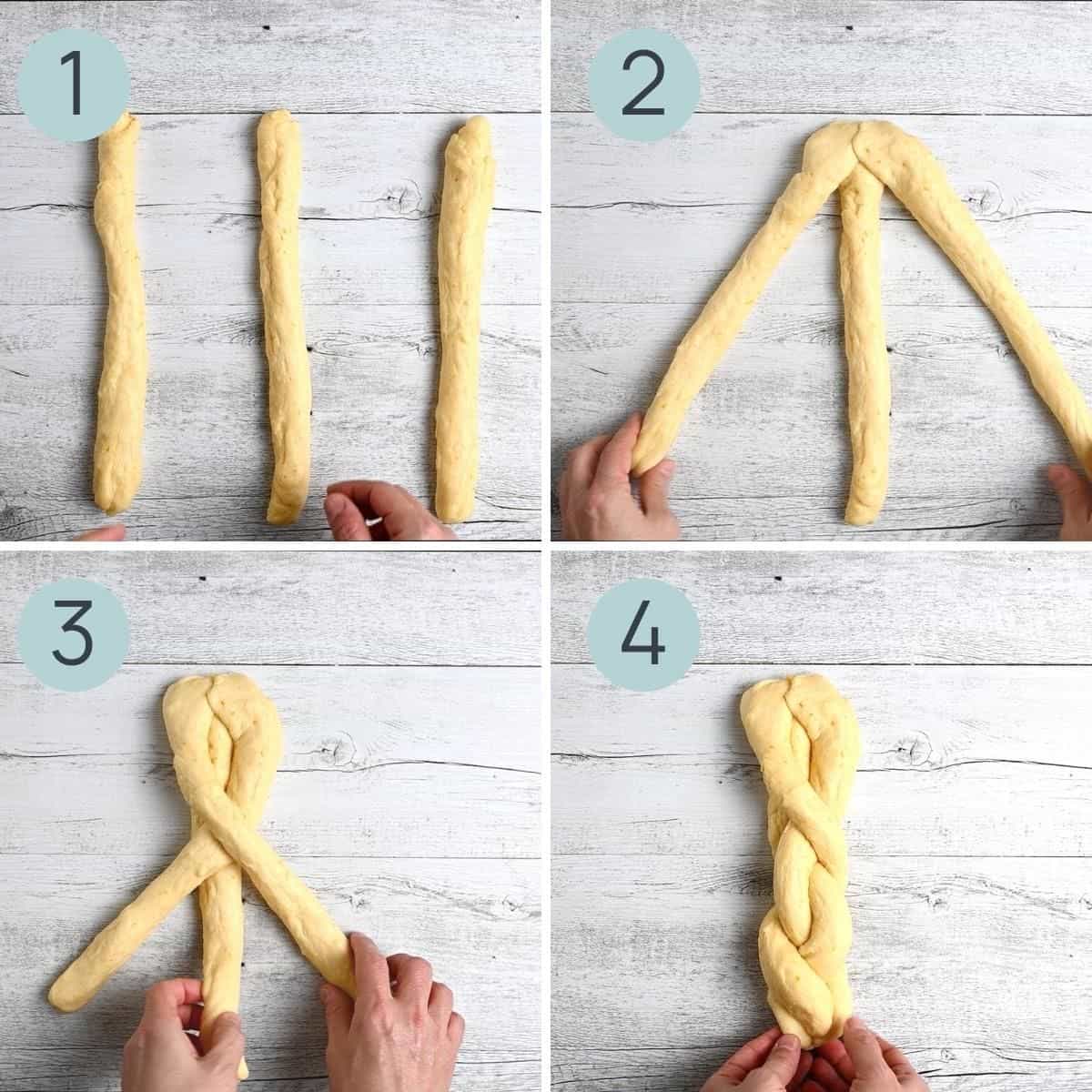
- Step 1: Lay three strips of dough in front of you.
- Step 2: Join the tsoureki ropes at the top - by pressing them together.
- Step 3: Form into braids. The braids need to be tight, so the bread does not expand sideways.
- Step 4: Tuck the bottom of the ropes under and press to seal.
Storing - Reheating - Freezing Instructions
- Store - place the tsoureki in an airtight container in the fridge for five days.
- Reheat - slice a piece and warm in the microwave for 15 seconds. Alternatively, toast it or heat it in a conventional oven or air fryer for a few minutes.
- Freeze - wrap the sweet bread in cling film and wrap again in foil. Freeze for up to 2-3 months. Then, allow it to thaw naturally before reheating and serving.
Expert tips
- Have patience. As is usual with bread recipes, there's a little time waiting for the dough to prove. However, follow the instructions, and you can't go wrong.
- Weigh the dough. I cannot stress this enough. When dividing the dough into ropes - make sure they are all even.
- Room temperature ingredients. All the ingredients should be at room temperature for the best success and allow the dough to rise evenly.
- Check your yeast. For any yeast-based sweet bread, ensure that your yeast is active. If you see no bubbles in the first blooming stage, start again with active yeast.
Serving suggestions
Serve the tsoureki with some homemade mandarin jam or blackberry jam for breakfast. Toast it first, and then top it to your heart's content!
FAQ's
It should have doubled in size and be a little sticky yet pliable.
These two are pretty similar. However, tsoureki is slightly sweeter and has mahlab and mastic's distinct taste and aroma.

Video
Related Recipes
If you've made this recipe or any other recipe on the blog - don't forget to rate it and leave a comment below. You can also follow the blog on Facebook, Instagram and Pinterest OR sign up to the Newsletter for the latest delicious recipes.
📋 Recipe

Tsoureki - Greek Easter Bread
Ingredients
- 250 ml milk
- 75 g butter, unsalted
- 650 g plain flour, all-purpose
- 1 teaspoon salt
- 1 orange, zested and juiced
- 7 g yeast, instant
- 170 g sugar, caster / superfine sugar
- 125 ml orange juice
- 3 eggs
- 2 teaspoon mahlepi, see note
For the glaze:
- 1 egg yolk
- 1 tablespoon milk
- flaked or slivered almonds, sesame seeds
Instructions
- Warm the milk in a saucepan over low heat. Add the butter stirring it into the milk, so it melts. Allow to cool.
- In a large bowl place 100 grams of the flour with the yeast, salt, orange zest and one teaspoon of the sugar. Pour in the cooled milk/butter mixture in and beat with a wooden spoon until you have a mix which resembles a thick batter. Cover with saran (plastic) wrap and a towel and leave it to rest for about half an hour.
- When you return, your mixture should be bubbling and doubled in size—place in the remaining flour, sugar, orange juice, mahlepi and eggs.
- Mix until a soft dough forms. If you find it's sticky, add more flour. But be careful not to add too much. We're after an elastic, silky dough. Knead for 10 minutes. Alternatively, you can follow these instructions using a stand mixer.
- Once kneaded place in an oiled bowl and lightly oil the top of the dough. Cover with plastic wrap and a kitchen towel and allow to rest for one hour or until doubled in size.
- When you notice it has doubled take it out and divide the mixture in two. With one of the halves, split into three equal portions and shape these three portions into "ropes". They should be of the same width and length. Mine measured approximately 30 cms.
- Lay down the tsoureki ropes in front of you. Join the top ends of the tsoureki with your fingers and squeeze so they stick together. Form a plait and tuck in the bottom ends so they stick together also. Brush with the glaze and add any almonds or sesame seeds on the top.
- Bake in a preheated 180 deg C fan forced / 200 deg C standard oven for 25 minutes until golden. They should sound hollow when tapped on the bottom. Allow cooling on a wire rack completely before slicing and serving,
Notes
- Have patience. As is usual with bread recipes, there's a little time waiting for the dough to prove. However, follow the instructions, and you can't go wrong.
- Weigh the dough. I cannot stress this enough. When dividing the dough into ropes - make sure they are all even.
- Room temperature ingredients. All the ingredients should be at room temperature for the best success and allow the dough to rise evenly.
- Check your yeast. For any yeast-based sweet bread, ensure that your yeast is active. If you see no bubbles in the first blooming stage, start again with active yeast.
Nutrition
This website provides approximate nutrition information for convenience and as a courtesy only. Nutrition data is gathered primarily from the USDA Food Composition Database, whenever available, or otherwise other online calculators.
© Souvlaki For the Soul
This post was first published in April 2021 but was updated with more information and video in April 2022.



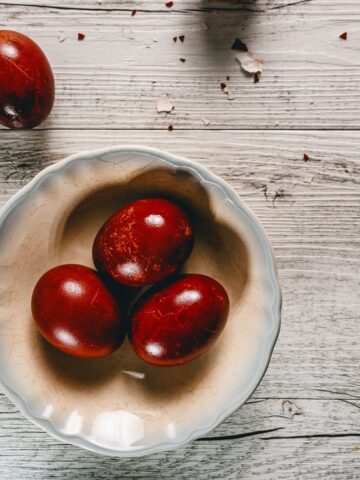


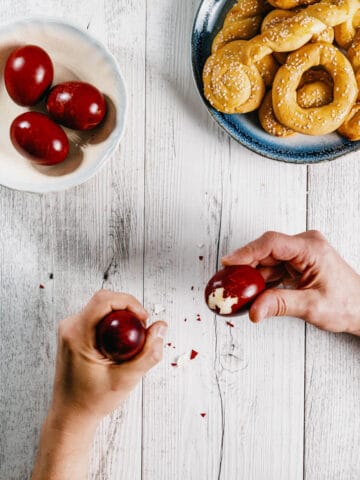



Sheryl O’Connor
I could not find the instructions for using the stand mixer for the kneading process.
Peter G
Everything you do by hand - just use the stand mixer instead. The recipe works both ways.
Penelope
Instead of knead by hand ,I can use the mixer?
Peter G
Yes. Absolutely!
Penelope
Do you recommend special white flour and for the yeast - yeast + bread improver?
Peter G
No. I always use regular all-purpose flour
Janice
I would love to try this for Easter this year--I'll be baking for Greek in-laws! I don't see mastic listed in the ingredients--how much should be used and when should it be added (I am guessing it's added in step 3)? thanks 🙂
Peter G
I can't always get hold of mastic - but yes - add it along with the dry ingredients.
cathy
how much mastic?
Peter G
One teaspoon is sufficient.